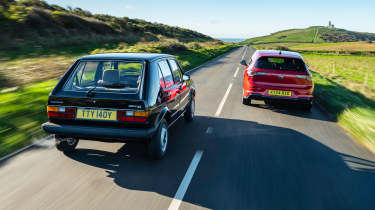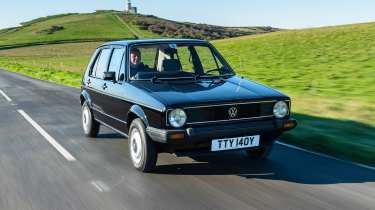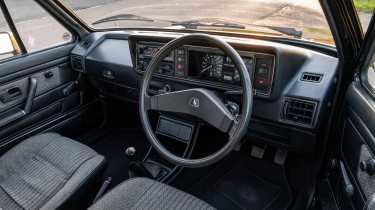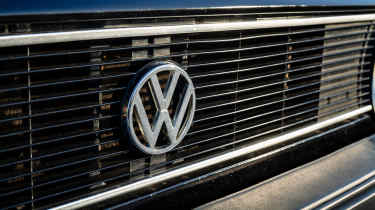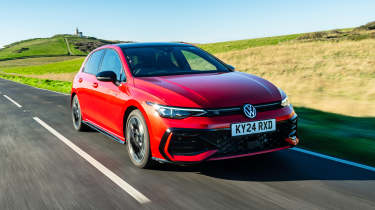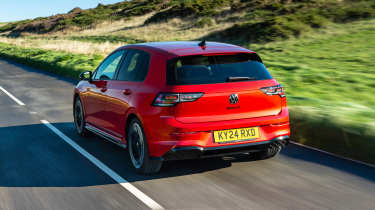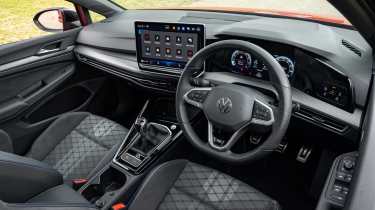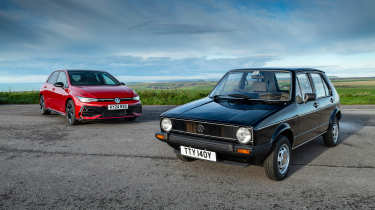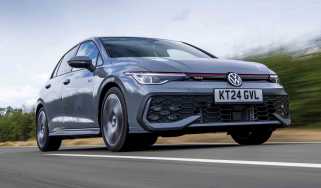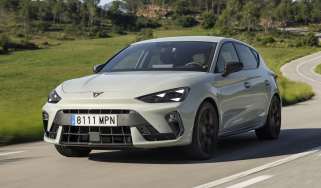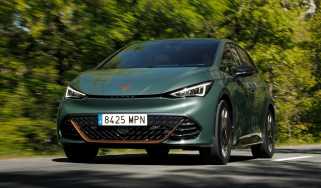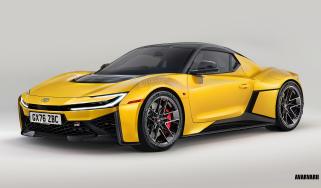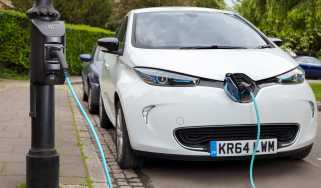Volkswagen Golf vs itself: original Mk1 head-to-head with today’s Mk8.5
VW’s legendary Golf is 50. We look at where it started, how it’s changed – and where it’s going
We’re guessing most people reading this won’t remember much about 1974 – the year in which President Nixon was forced to resign following the Watergate scandal, Muhammad Ali beat George Foreman in the Rumble in the Jungle, and West Germany scored victory in the football World Cup again, having first won it in 1954.
Equally significantly, on 29 March ’74 Volkswagen built its first Golf, the model tasked with replacing the mighty Beetle, VW’s ‘car of the people’ and easily its most popular – and lucrative – vehicle up to then. The newcomer was named not after the game but, instead, the Gulf Stream climactic event. Probably. Some VW historians reckon the car might actually have been so-designated after a horse belonging to one of Wolfsburg’s top brass at the time: no one at the company seems sure which particular origin story is true.
Whatever or whoever it was named after, the car designed by Italdesign’s Giorgetto Giugiaro was born fully five decades ago this year, since when it hasn’t looked back. Now in its 10th iteration, if you count the Mk7.5 and the latest Mk8.5 versions as models within their own right, the Golf has become the world’s third biggest-selling model, with more than 37 million being bought worldwide thus far. Half a century after its invention, the hatch still defines VW as a car company: as the car company, as far as many Europeans are concerned.
It’s also one of the most influential models ever when it comes to placing cutting-edge engineering in the hands of the many, rather than just the few. It’s pioneered a lot of tech for the mainstream over the decades, including anti-lock brakes, five, six and seven-speed gearboxes, including the dual-clutch system, air-conditioning, airbags... you name it. Across the years the Golf has consistently introduced game-changing tech to the common man and woman, long before its key competitors.
More reviews
Car group tests
- BMW 128ti vs Volkswagen Golf GTI: understated hot hatches have plenty of used appeal
- Volkswagen Golf vs Skoda Octavia: a battle for family hatchback supremacy
In-depth reviews
Road tests
There have been many high points, and some less memorable ones, too. Such fluctuations in form are, of course, inevitable during the evolution of a car that’s been on sale for more than 2,600 weeks. You can read about the peaks and troughs in more detail further on, but the broader point is that whenever VW has made mistakes with the Golf, it has tended to fix them pretty quickly.
Ultimately the brand’s ability to recognise the issues, react to them and reinvigorate the Golf is why the car has matured so gracefully across the generations. Through thick and thin, following good decisions and bad, VW has never given up on it – despite the rank mediocrity of certain versions such as the Mk4 GTI and, in more recent times, the disappointingly under-developed Mk8.
True to form, however, VW has bounced right back. As we’ll see, the latest model is vastly improved in nearly every respect. The Golf, it seems, isn’t ready to roll over. It continues to mean far too much to VW – both financially and emotionally – for that to be allowed to happen.
Fifty years on, it remains the most important car for Europe’s most successful automotive brand – with an all-new, all-electric Mk9 confirmed for 2028. That’s good news for all Golf fans, as well as for VW’s future prosperity. So let’s go back to the beginning, to find out how and why it all began.
The original
The first thing that strikes you about the Golf Mk1 is its size. Even in isolation it looks tiny, more like a very large toy rather than an actual car. Place it beside the latest Mk8.5 on the road, however, and it shrinks even further. It looks half the size of the new Golf from most angles.
Yet climb inside, and somehow the Mk1 still manages to contain enough space to accommodate the same five human beings as the Mk8.5, albeit more cosily across its rear bench seat. Thumb the little chrome button on the tailgate, and you’ll also find a decent boot – one that’s unusually deep, at the bottom of which you’ll also discover a full-size spare wheel. The latest Golf contains no spare, not even a skinny.
There are many aspects of these two cars, separated by half a century of evolution, that will amaze you, even sometimes leave you giggling in disbelief. But the differences in the way they’re packaged is probably the most revealing thing. The Mk1 weighs a mere 805kg – yes, you read that right – and, as we said, dimensionally it is
a titch beside its latest descendant. Yet it can still transport the same number of people.
In this respect the Golf has made no progress whatsoever in the past 50 years. Its increase in size has merely added luxury to the experience of travelling – and indeed, it has removed some practicality in the infuriating absence of that aforementioned spare wheel – which says as much about our evolution as a species during this time as it does about the cars we now drive. All of which have got bigger, but not necessarily more practical in fundamental terms.
On the other hand, there are numerous aspects of the Mk1 that show just how far we have progressed, too. For example, take its manual choke, which works well enough, but still needs to be used on a cold morning to prevent the 70bhp 1,457cc engine from stalling. This is in contrast to the Mk8.5, whose directly injected motor simply starts and runs smoothly at the press of a button, without you so much as thinking about it. Just
as all Golf engines have done for decades.
Elements such as power-steering, central locking, air-conditioning, decent sound deadening and instruments you can actually read at night also seem glaringly absent from the old-timer. Even the driving position appears archaic by comparison, mainly because the seat itself is so spongy beside that of any modern car’s, while the pedals – all three of them – appear utterly petite down in the footwell.
You can still heel and toe in the Mk1 if you fancy it, and your left foot can find the clutch naturally enough, despite the pedal looking more like a small button. However, the absence of power-steering means any low-speed manoeuvre is performed with a flailing of both arms and shoulders – rather than a mere flick of the wrists as in its Mk8.5 descendant – and the more time you spend with the Mk1, the more you realise how much more physical it is to drive, or even just to climb into and operate.
Inside the cabin, everything that moves requires more effort than in the latest car, from the steering to the clutch, even simply opening a door or altering the rear-view mirror. We’ve become used to things that glide serenely into position, using either motors or carefully damped springs – VW having pioneered such luxuries for the mainstream via the Golf. So although the Mk1 appears old and delicate in many ways, it also demands a lot more of you physically to drive. There’s more friction than you expect in each of its moving parts, most of which are less easy to manipulate than we have since become accustomed to.
The consensus, of course, suggests this is an entirely good thing, but maybe we’ve become lazy in our endless quest for increased refinement. Perhaps a bit of a heave-ho to make things work isn’t such a bad thing – or maybe it’s simply a pain in the neck, one that automotive evolution has removed from the modern equation, and rightfully so.
Either way, on the move you can feel every grain in the road beneath the tyres, via the Mk1’s unpowered steering. Most of the time this is delightful to experience, albeit in a thoroughly old-fashioned kind of way. Some of the feedback that reaches your hands is unwanted – such as the violent kickback that ricochets up through your wrists over expansion joints or potholes – but there’s also an intimacy to the way you guide this car along the road that is pure and lovely, and which is never replicated in the latest model.
What evolution gives with one hand, it takes away with the other, it appears – although overall there is no question about it: the old car is hugely less capable than its new counterpart when it comes to things such as ride quality, mechanical refinement, interior comfort, speed, agility and dynamic precision.
The latest Golf is effortlessly brisk, which we’ll come to in a while, yet once again the old-timer has enough raw performance to at least be able to keep up with it on most roads. It’s not so slow or underpowered that you must make allowances for it; in other words, not as you would need to do for a car that’s 60, rather than 50, years old.
Its 1.5-litre four-cylinder engine still manages to generate a quite perky 70bhp and 110Nm, enough to provide it with a reasonable turn of speed, even today. Its claimed 0-60mph time is 12.7 seconds, and its top speed is high enough to land you in trouble on most roads in 2024.
In this respect the Mk1 Golf represents the point at which cars had already started to become too quick for our roads, if driven irresponsibly – whereas only 10 years before that most family cars couldn’t break the national speed limit even if they tried.
The Mk1 Golf was very much a landmark car in the way it introduced such modern technology – and performance – to the mainstream. In 1974 it must have seemed impossibly cutting edge, and quick, relative to most other family cars that were on sale at the time. And even today it still doesn’t feel or look overtly vintage. It has aged quite extraordinarily well.
Because of its genius, it set the tone for an entire lineage of world-class hatchbacks – the latest of which you can read more about below.
The latest
On the basis that every action has a consequence, the significance of which grows exponentially as time clicks by – some call it the ‘butterfly effect’ – it was inevitable that ‘Dieselgate’ would have a profound effect on VW’s trajectory at some point. In this case, that consequence arrived in the form of the Golf Mk8, which – mainly because of the fines imposed on the company following the scandal – somehow managed to be both over-complicated and under-developed compared with its predecessor, the brilliant Mk7.5. Overall, it was far from Wolfsburg’s finest hour.
Yet in the Mk8.5 that followed, Volkswagen has once again turned things around for the Golf. Right around. The result is a car that’s better than its predecessor in every way: to drive, to be in, to live with and to interact with. Whatever it is you choose to do in or with a family hatchback, the Mk8.5 does it miles better than the Mk8.
Is it good enough, therefore, to stand comparison with the legendary Mk1 – and, if so, does the new Mk8.5 crystallise the legacy of the Golf as a brand? Yes, and absolutely. We would say its evolutionary progress is every bit as significant as that achieved by the Mk5 when it replaced the woeful Mk3 and Mk4 at the beginning of this century. That’s how big a step the 8.5 represents – not only over its misguided predecessor, but for the Golf full-stop.
On the surface, the signs of such a radical improvement aren’t entirely obvious. There’s a range of subtle but effective styling tweaks to the exterior, many of which you’d be hard-pressed to spot in isolation, but which collectively provide the 8.5 with a genuinely fresh feel (think new LED lights, illuminated VW badges, redesigned front and rear bumpers plus a range of fresh colours and alloy wheel designs). All good stuff, but nothing major, visually.
Climb inside the cabin, however, and the improvements are somewhat easier to spot – and to appreciate, as well. To its credit, VW has swallowed hard and binned most of the things with which Mk8 drivers had become so disillusioned, including the haptic controls on the steering wheel, on which there are now buttons instead. As such, the Mk8.5’s cabin has a much more intuitive, more Golf-like feel to it – one that seems impossibly modern and refined in comparison with the Mk1, but still manages to bear an obvious relationship with the original, whereas the Mk8 almost felt like a different species inside.
The same goes for the way the Mk8.5 drives. In theory VW hasn’t altered much. The test car you see here (an R-Line 1.5 TSi) still comes with a 1.5-litre four-cylinder engine that’s been lightly turbocharged to produce 148bhp and 250Nm, enough to send it from 0-62mph in 8.6 seconds and on to a top speed of 139mph. Its power reaches the road via a six-ratio manual gearbox that feels implausibly slick beside that of the Mk1’s four-speeder, but which still retains a pleasant degree of mechanical precision after the Mk8, whose manual box did not impress.
On the move the 8.5 initially seems enormous and weirdly anaesthetised beside the smaller, more intimate and more immediate Mk1. That’s inevitable given its evolution over the past half century. Yet the more time you spend in the 8.5, the more it makes sense, and the more ‘right’ it feels – beside the old car, yes, but more so compared with its most recent predecessor.
The ride, steering, brakes, gearchange, throttle response and even the damping all seem more cohesive than in the Mk8. There’s a polish to everything the 8.5 does on the move that somehow went missing in the previous Golf – and what you eventually realise if you spend enough time swapping between this new car and the Mk1 is that they genuinely share quite a lot of fundamental qualities. And whatever these are – connection, mechanical fluidity, precision, call them what you will – they went AWOL in the Mk8, but have returned with a bang in the 8.5.
As a result, the link between the Mk1 and Mk8.5 is strong and obvious, even though they are separated by half a century of evolution. You can detect the same resistance to inertia that so defines the Mk1 in the 8.5’s steering response, and in the way the latter model controls its body so cleanly when you turn into a corner. Or even when you open its throttle or depress the clutch.
In pretty much everything it does on the move, dynamically the 8.5 feels like a (much) more contemporary version of the same car as the Mk1, whereas the Mk8 did not. In that car the entire guidance system felt different, as if VW had made the Golf for someone else; for people who aren’t all that fussed about how their car goes down the road. How it drives and feels, in other words.
But fear not. The brand has seen the light and realised once again just how important the Golf’s core DNA is as far as its credibility – and thus its success – are concerned. For the Mk8.5, this has been reproduced once again in spades.
Fingers crossed it’ll still be there in 2028 when the Mk9 appears, but in the meantime take comfort from the fact that all is well and good again with the car that may or may not be named after a vital climactic event. Fifty years on – in Mk8.5 guise, at least – the force of that wind blows as strong as ever. Once again the Golf has become the car to beat, the high watermark in its class, the best family hatch money can buy.
Our verdict
A lot has changed in the world since 1974, but, half a century on, the Volkswagen Golf remains an icon at the top of its game. In this latest Mk8.5 guise it is still, we sincerely believe, the best family hatchback on the global market.
Such enduring success is entirely unprecedented within the world of family cars, but it is also at the heart of VW’s success. Without the Golf, it wouldn’t be half the automotive company it is today. The model itself hasn’t always been perfect, having suffered numerous fluctuations in form over the decades. But invariably VW has turned things around and reinvigorated its icon when necessary.
The Mk8.5 sees the car right on top of its game again – the ball having been well and truly dropped by its Mk8 predecessor – and so it goes on. The next version won’t be with us before 2028, until which time the automotive world will once again have to hold its breath...
The highs and lows
Nothing will top the Mk1, of course, because the original Golf remains the most significant of all. Yet the Mk2
was one heck of a strong follow-up, especially in GTI 16v guise, whereas the Mk3 was the opposite. By then
VW had decided to milk the brand by charging more for a car on which it had spent less. The disappointing result was a shadow of its predecessors.
VW then thought it had righted the ship with the Mk4. The regular versions were good cars – far more thoroughly engineered machines than their immediate predecessors – but for whatever reason the GTI remained misguided. Beside a Mk2 GTI 16v, it was simply an embarrassment.
By then, rivals had started to build some seriously good machinery such as the Ford Focus, so for the Mk5 VW wisely decided to go the extra mile and spend more time – and money – on the underpinnings. The result was a major return to form for the Golf, and for the GTI versions especially. The Mk6 was then a mildly re-engineered, restyled iteration of the Mk5, and there was not a lot wrong with that.
And then came the Mk7, followed a few years later by the even better Mk7.5, both of which hit the bullseye
in a way that only the original, the Mk2 and the Mk5 had managed. Except that the Mk7 – in all its forms, but none more so than in GTI and R guises – introduced tech no Golf driver had ever seen before. In the R especially, the Mk7 and Mk7.5 were exceptional, combining supercar-chasing dynamics with fine build quality and a major dose of practicality. Beside them, the Mk8 that followed seemed at best weak, at worst misguided, although fortunately the Mk8.5 has righted most of its wrongs.
Which Golf GTI would you rather drive? Tell us in the comments section...


